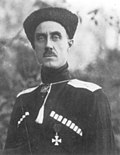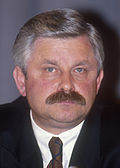List of heads of state of Russia
This is the list of the heads of state of Russia after the monarchy had been abolished in 1917.
Russian Republic (1917–1918)
[edit]With the abdication of Emperor Nicholas II after the February Revolution of 1917, power in Russia passed to the Provisional Government formed by the liberal leadership of the Duma. Grand Duke Michael had refused to ascend to his older brother's throne without the consent of an elected Constituent Assembly, and it was broadly assumed that the Assembly would be the only body with the authority to change the form of government. However, after a failed coup attempt against the government, the Russian Republic was proclaimed by Minister-President Kerensky. The election was scheduled for 25 [O.S. 12] November 1917, yet when it finally took place, the power in the capital city of Petrograd had already switched to the Bolshevik revolutionaries. By that time, the government had been de facto dissolved, and the newly elected Assembly was also disbanded after its very first session by the Bolsheviks on 19 January 1918.
| # | Picture | Name | Term of office | Party | |
|---|---|---|---|---|---|
| Chairmen of the Provisional Government | |||||
 | Georgy Lvov (1861–1925) | 15 March 1917 | 21 July 1917 | KD | |
 | Alexander Kerensky (1881–1970) | 21 July 1917 | 14 September 1917 | PSR (Trudovik faction) | |
| Minister-President | |||||
 | Alexander Kerensky (1881–1970) | 14 September 1917 | 7 November 1917 | PSR (Trudovik faction) | |
| Office vacant (until 19 January 1918) | |||||
Russian State (1918–1920)
[edit]The October Revolution sparked a civil war across the former Russian Empire, with the most prominent factions being the Bolsheviks, loosely connected anti-Bolshevik governments and armies known as the White movement, as well as numerous independence movements loosely aligned with the Whites. Various anti-Bolshevik governments began to form across Russia since early 1918, initially emerging among the cossacks of Don and Kuban. In September 1918, the largest factions united into the Provisional All-Russian Government, creating the Russian State. Two months later, Admiral Alexander Kolchak headed the Russian State as a Supreme Ruler in result of a military coup. After Kolchak's defeat in 1920, the White movement started to decline, with most of its members leaving Russia in November 1920 under the command of General Pyotr Wrangel. Various social-democratic governments continued to function until June 1923, when the Bolsheviks suppressed the Yakut revolt in Priamurye.
| # | Picture | Name | Term of office | Party | |
|---|---|---|---|---|---|
| Chairmen of the Provisional Siberian Government | |||||
 | Pyotr Derber (1883–1938) | 29 January 1918 | 29 June 1918 | PSR | |
 | Pyotr Vologodsky (1863–1925) | 30 June 1918 | 3 November 1918 | PSR | |
| Chairman of the Committee of Members of the Constituent Assembly | |||||
 | Vladimir Volsky (1877–1937) | June 1918 | September 1918 | PSR | |
| Chairman of the Provisional All-Russian Government | |||||
 | Nikolai Avksentiev (1878–1943) | 23 September 1918 | 18 November 1918 | PSR | |
| Supreme Ruler | |||||
 | Alexander Kolchak (1874–1920) | 18 November 1918 | 7 February 1920 † | White movement | |
| Commanders-in-Chief of the Armed Forces of South Russia | |||||
 | Anton Denikin (1872–1947) | 8 January 1919 | 4 April 1920 | White movement | |
 | Pyotr Wrangel (1878–1928) | 4 April 1920 | 21 November 1920 | White movement | |
| Chairmen of the Provisional Priamurye Government | |||||
 | Spiridon Merkulov (1870–1957) | May 1921 | 23 July 1922 | White movement | |
 | Mikhail Diterikhs (1874–1937) | 23 July 1922 | 25 October 1922 | White movement | |
 | Anatoly Pepelyayev Acting | 25 October 1922 | 16 June 1923 | White movement | |
Russian Soviet Federative Socialist Republic (1917–1991)
[edit]On 30 December 1922, the Russian Soviet Republic, along with the Soviet pro-Bolshevik republics of Ukraine, Belarus and the Southern Caucasus were merged into the Soviet Union, with the Russian SFSR authorities holding the authority of the highly centralized country, which was governed by a leader of the Communist Party or a collective leadership (Politburo). In 1938, the Supreme Soviet of the RSFSR was formed. Following the adoption of amendments to the Constitution in 1989, the office of Chairman of the Presidium was removed, and the position of the Russian head of state passed directly to the Chairman of the Supreme Soviet in May 1990.
During nearly all Soviet era, 1917–1990, the de-facto rulers were the leaders of the Communist Party of the Soviet Union; see List of leaders of the Soviet Union.
| No. | Portrait | Name (Birth–Death) | Term of office | Political party | |
|---|---|---|---|---|---|
| Took office | Left office | ||||
| Chairman of the Central Executive Committee of the All-Russian Congress of Soviets (1917–1938) | |||||
| 1 |  | Lev Kamenev (1883–1936) | 9 November 1917 | 21 November 1917 | Communist Party |
| 2 |  | Yakov Sverdlov (1885–1919) | 21 November 1917 | 16 March 1919 | Communist Party |
| — |  | Mikhail Vladimirsky (1874–1951) Acting | 16 March 1919 | 30 March 1919 | Communist Party |
| 5 |  | Mikhail Kalinin (1875–1946) | 30 March 1919 | 15 July 1938 | Communist Party |
| Chairman of the Supreme Soviet of the Russian SFSR (1938) | |||||
| 6 |  | Andrei Zhdanov (1896–1948) | 15 July 1938 | 19 July 1938 | Communist Party |
| Chairman of the Presidium of the Supreme Soviet of the Russian SFSR (1938–1990) | |||||
| 7 |  | Aleksei Badayev (1883–1951) | 19 July 1938 | 9 April 1943 | Communist Party |
| — | Ivan Vlasov (1903–1969) Acting | 9 April 1943 | 4 March 1944 | Communist Party | |
| 8 |  | Nikolai Shvernik (1888–1970) | 4 March 1944 | 25 June 1946 | Communist Party |
| 9 | Ivan Vlasov (1903–1969) | 25 June 1946 | 7 July 1950 | Communist Party | |
| 10 | Mikhail Tarasov (1899–1970) | 7 July 1950 | 16 April 1959 | Communist Party | |
| 11 | Nikolai Ignatov (1901–1966) | 16 April 1959 | 26 November 1959 | Communist Party | |
| 12 | Nikolai Organov (1901–1982) | 26 November 1959 | 20 December 1962 | Communist Party | |
| (11) | Nikolai Ignatov (1901–1966) | 20 December 1962 | 14 November 1966 | Communist Party | |
| 13 | Mikhail Yasnov (1906–1991) | 23 December 1966 | 26 March 1985 | Communist Party | |
| 14 | Vladimir Orlov (1921–1999) | 26 March 1985 | 3 October 1988 | Communist Party | |
| 15 | Vitaly Vorotnikov (1926–2012) | 3 October 1988 | 29 May 1990 | Communist Party | |
| Chairman of the Supreme Soviet of the Russian SFSR (1990–1991) | |||||
| 16 |  | Boris Yeltsin (1931–2007) | 29 May 1990 | 10 July 1991 | Independent |
| President of the Russian SFSR (1991) | |||||
| (16) |  | Boris Yeltsin (1931–2007) | 10 July 1991 | 25 December 1991 | Independent |
Russian Federation (since 1991)
[edit]On 17 March 1991, the all-Russian referendum on the introduction of presidency was held. More than 70% of citizens voted for the introduction of the office. On 12 June, Boris Yeltsin won 57% of the popular vote in the first democratic presidential election. Yeltsin's inauguration took place on 10 July. On 12 December, Russia ratified the Belovezh Accords, thus dissolving the Soviet Union. On 25 December, the Russian Soviet Federative Socialist Republic was renamed Russian Federation, with the names of the state and its highest executive office constitutionally amended in 1992. The office got its current status with the adoption of a new constitution in 1993, following an armed dispute between the president and the parliament.
| Presidents | ||||||
|---|---|---|---|---|---|---|
| # | Picture | Name | Term of office | Elected | Party | |
| 1 |  | Boris Yeltsin (1931–2007) | 10 July 1991 | 21 September 1993 | 1991 | Independent |
| — |  | Alexander Rutskoy Acting; disputed | 22 September 1993 | 4 October 1993 | — | Independent |
| 1 |  | Boris Yeltsin (1931–2007) | 4 October 1993 | 5 November 1996 | — | Independent |
| 1996 | ||||||
| — |  | Viktor Chernomyrdin Acting | 5 November 1996 | 6 November 1996 | — | Our Home – Russia |
| 1 |  | Boris Yeltsin (1931–2007) | 6 November 1996 | 31 December 1999 (resigned) | — | Non-partisan |
| — |  | Vladimir Putin (b. 1952) | 31 December 1999 | 7 May 2000 | — | Unity |
| 2 | 7 May 2000 | 7 May 2008 | 2000 | Independent | ||
| 2004 | ||||||
| 3 |  | Dmitry Medvedev (b. 1965) | 7 May 2008 | 7 May 2012 | 2008 | United Russia All-Russia People's Front |
| (2) |  | Vladimir Putin (b. 1952) | 7 May 2012 | Incumbent | 2012 | All-Russia People's Front |
| 2018 | ||||||
| 2024 | ||||||
Timeline
[edit]


 French
French Deutsch
Deutsch